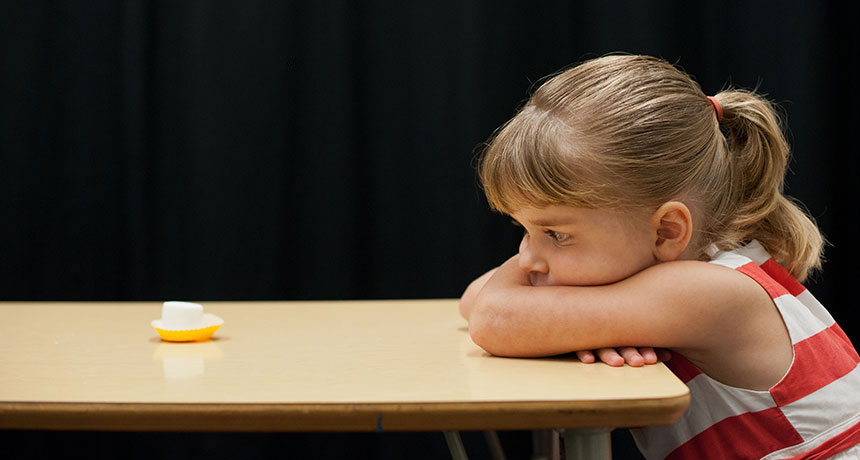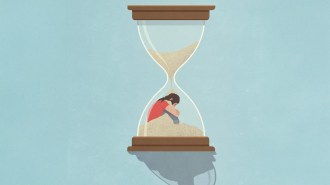Kids today are waiting longer than ever in the classic marshmallow test
Researchers aren’t sure what’s driving this willingness to delay gratification

HOLD OUTS Over the past 50 years, white, middle-class kids have shown an increasing willingness to delay gratification on the marshmallow test, a new study finds. Reasons for this trend, and the relationship of marshmallow test scores to later behavior, are unclear.
J. Adam Fenster/Univ. of Rochester
Hold that marshmallow and don’t ask for s’more.
Some kids today wait much longer to get an extra treat in the famed marshmallow test than they did in the 1960s or even the ‘80s, researchers say. So, so much for the view that internet-savvy, smartphone-toting tykes want what they want at warp speed.
This willingness to delay gratification has recently bloomed among U.S. preschoolers from predominantly white, middle-class families, say psychologist Stephanie Carlson of the University of Minnesota in Minneapolis and her colleagues. Youngsters aged 3 to 5 in the 2000s waited an average of two minutes longer during the marshmallow test than children in the 1960s did, and an average of one minute longer than 1980s kids did, the scientists report June 25 in Developmental Psychology.
Reasons for kids’ rising patience when confronted with an available treat are unclear. Carlson’s team offers several possible explanations, including increases in the ability to think abstractly, pay attention, plan and prioritize that have been linked to preschool attendance and early use of digital technologies.
From the start, the marshmallow test has examined kids’ willingness to resist an available goody while waiting 10 to 15 minutes to receive double the edible pleasure. In this case, extra treats were doled out if a child waited a full 10 minutes for an experimenter who had left to return. Researchers have assumed the test taps into an enduring ability to control oneself, although responses can vary greatly across cultures (SN: 8/5/17, p. 13).
“The marshmallow test cannot determine a child’s future, but it is a reliable indicator of how well kids can reflect on a challenging situation and come up with strategies to achieve their goal,” Carlson says. “That may portend well for school and social situations.”
But the new findings don’t address whether youngsters’ willingness to delay gratification in the lab translates into an ability to resist everyday temptations, says study coauthor Walter Mischel of Columbia University, the psychologist who directed the first marshmallow tests in the 1960s (SN: 11/15/14, p. 28).
In the new study, the team analyzed and compared data from three groups of 3- to 5-year-olds: 165 kids who completed the marshmallow test between 1965 and 1969, 135 who did so between 1985 and 1989, and 540 tested between 2002 and 2012.
The average amount of time kids were willing to wait for a treat increased in each generation — from about five minutes in the ‘60s to six minutes in the ‘80s and seven minutes in the 2000s. That trend was observed among both boys and girls, younger and older preschoolers and kids in different parts of the United States.
It’s not known if the same trend applies to kids from poor and nonwhite families. Some previous evidence suggests children on the lower end of the economic scale often choose an immediate but lesser treat on the marshmallow test, Carlson says. That behavior may make sense if children live in unpredictable settings or don’t trust adults who promise future treat bonuses (SN: 11/17/12, p. 10).
Carlson’s findings follow a report, published May 25 in Psychological Science, indicating that long wait times on the marshmallow test are only weakly linked to school success and healthy behavior as a teenager. Studies of kids who took the marshmallow test in the 1960s had suggested the opposite (SN: 5/27/89, p. 325).
Psychologist Tyler Watts of New York University and his colleagues analyzed academic and behavioral data for 918 teens, all age 15, who had taken the marshmallow test in 1995 or 1996 at age 4½. Of that number, 552 were born to mothers who had not graduated college. Many of these youngsters came from lower-middle class or poor homes.
Kids whose mothers had college degrees waited an average of almost 5.4 minutes on the marshmallow test, versus an average of almost four minutes for children whose mothers hadn’t graduated from college. But little evidence for a link between delaying gratification in childhood and teen achievement appeared after accounting for other mental abilities, including early verbal and math skills.
An increasing percentage of mothers have graduated from college in recent years, which could help explain why kids today wait longer on the marshmallow test, says psychologist Terrie Moffitt of Duke University. But it’s difficult to compare findings from different marshmallow tests, she says. Kids’ willingness to wait for extra treats can change due to unmeasured factors that vary across studies, such as instructions given to children, the test setting and even the size and color of marshmallows, Moffitt holds.
What’s striking is that nearly 60 percent of preschoolers tested in the 2000s waited out the entire 10-minute delay period, versus almost 40 percent in the 1980s and about 30 percent in the 1960s, says Duke psychologist Avshalom Caspi. Perhaps performance on the marshmallow test no longer predicts teen achievement because most kids are now waiting the same amount of time for extra treats, he suggests. If a test doesn’t elicit a wide variety of scores from children, that test’s ability to forecast later behavioral differences suffers.







